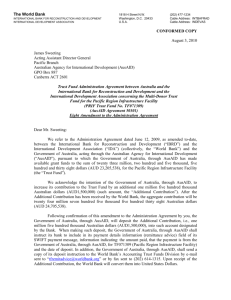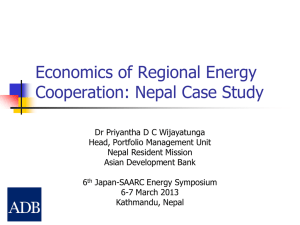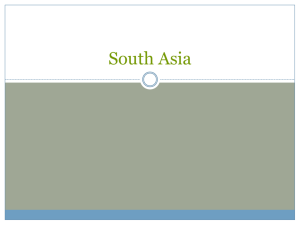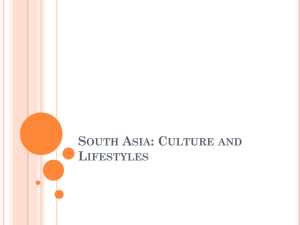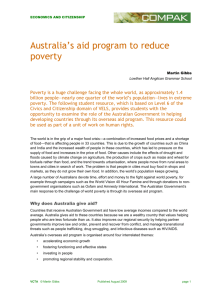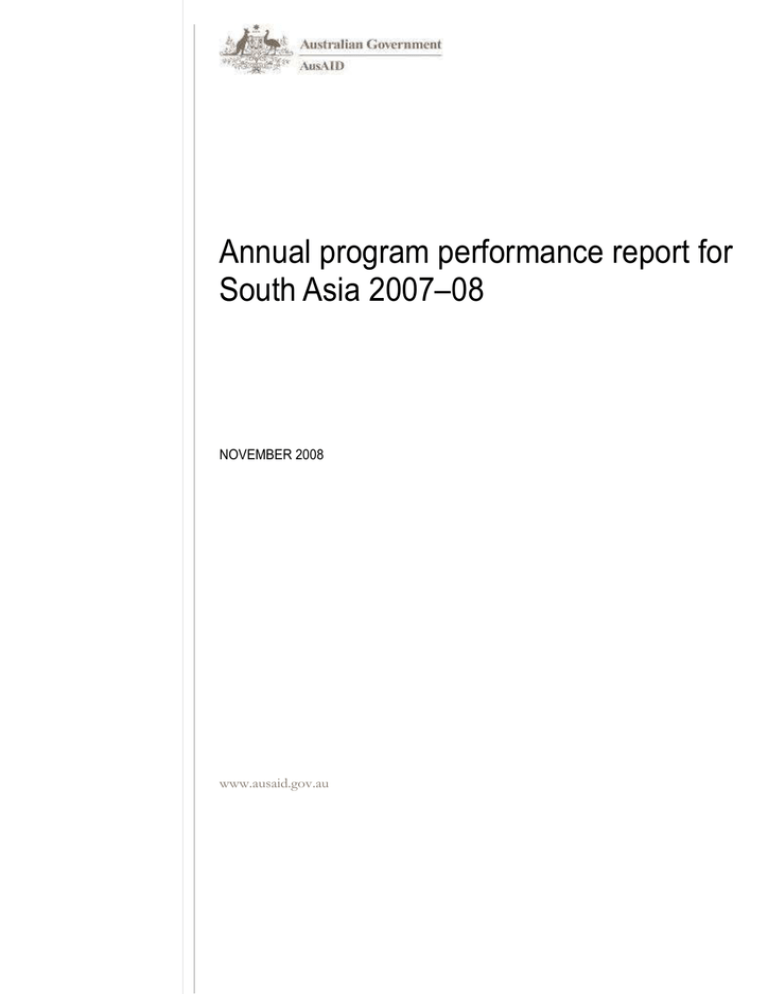
Annual program performance report for
South Asia 2007–08
NOVEMBER 2008
www.ausaid.gov.au
© Commonwealth of Australia 2016
This work is copyright. You may download, display, print and reproduce this material in
unaltered form only (retaining this notice) for your personal, non-commercial use or use
within your organisation. Apart from any use as permitted under the Copyright Act 1968,
all other rights are reserved. Requests and inquiries concerning reproduction and rights
should be addressed to Commonwealth Copyright Administration, Attorney General’s
Department, Robert Garran Offices, National Circuit, Barton ACT 2600 or posted at
http://www.ag.gov.au/cca
ISBN 978 1 921285 46 2
Published by the Australian Agency for International Development (AusAID), Canberra,
November 2008.
Annual Program Performance Reports are prepared in accordance with AusAID’s
Performance Assessment and Evaluation Policy. The reports are self-assessments and
represent the views of program areas.
This document is online at www.ausaid.gov.au/publications
For further more information about the Australian Government’s
international development program, contact:
Communications Section
AusAID
GPO Box 887
Canberra ACT 2601
Phone (02) 6206 4000
Facsimile (02) 6206 4880
Internet www.ausaid.gov.au
2
AUSAID ERROR! NO TEXT OF SPECIFIED STYLE IN DOCUMENT.
Contents
ABBREVIATIONS
4
SUMMARY
5
REGIONAL PERFORMANCE
7
Millennium Development Goals
7
Common barriers to development
8
Australia and other donors
9
WHAT ARE THE RESULTS OF THE SOUTH ASIA PROGRAM?
10
Objective 1: To promote good governance and contribute to improved basic service
delivery (with a focus on health, education and natural resource management at the state
and community level)
10
Objective 2: Respond, in line with Australia’s capacity, to humanitarian needs and issues
of mutual concern to the governments of South Asia and Australia, as they emerge
12
Key development effectiveness issues
13
WHAT IS THE QUALITY OF AUSAID ACTIVITIES IN SOUTH ASIA?
16
Achieving objectives
16
Implementation progress
17
Sustainability
17
Monitoring and evaluation
18
AUSAID ERROR! NO TEXT OF SPECIFIED STYLE IN DOCUMENT.: ERROR! NO TEXT OF SPECIFIED STYLE IN DOCUMENT.
3
Abbreviations
4
ADB
Asian Development Bank
AIDS
Acquired Immune Deficiency Syndrome
AusAID
Australian Agency for International Development
HIV
human immunodeficiency virus
IMF
International Monetary Fund
NGO
non-government organisation
UN
United Nations
UNAIDS
Joint United Nations Programme on HIV/AIDS
AUSAID ERROR! NO TEXT OF SPECIFIED STYLE IN DOCUMENT.: ERROR! NO TEXT OF SPECIFIED STYLE IN DOCUMENT.
Summary
South Asia is home to 1.5 billion people, 23 per cent of the world’s population, with an
estimated 400 million people still living in absolute poverty. The region will have a
serious impact on global achievement of the Millennium Development Goals, yet
progress towards these goals in South Asia is insufficient to meet 2015 targets and
progress has been marked by persistent social inequalities.
The South Asia aid program consists of country programs in Bangladesh, Nepal,
Sri Lanka, India, Maldives and Bhutan, and a regional program that addresses aid
priorities on a regional or multi-country basis and includes some support to Pakistan and
Afghanistan. The program’s progress towards achieving its two objectives is summarised
in Table 1.
TABLE 1
RATINGS OF THE SOUTH ASIA PROGRAM IN ACHIEVING ITS OBJECTIVES
Objective
Rating
Objective 1: To promote good governance and contribute to improved basic service delivery (with a focus on health,
education and natural resource management at the state and community level)
(green)
Objective 2: Respond, in line with Australia’s capacity, to humanitarian needs and issues of mutual concern to the
governments of South Asia and Australia, as they emerge
(green)
Note: (green) denotes the objective is on track to be fully achieved within the timeframe.
Major program achievements include:
strengthening the national education system and providing support to educate
1 million disadvantaged children in Bangladesh
providing support to meet the basic humanitarian needs of 300 000 people displaced
by violent civil conflict in Sri Lanka
providing support for the provision of potable water to more than 200 000 people in
western Nepal
helping to maintain national vitamin A coverage in Nepal at over 95 per cent
improving the livelihoods of more than 100 000 families and 90 000 children from
among the ultra-poor in Bangladesh
strengthening government capacity to address HIV/AIDS among intravenous drug
users
implementing important community rehabilitation programs and peace-building
processes in conflict-affected areas in Sri Lanka
leveraging US$860 million in World Bank lending for governance reform as a result
of activities under the Australia–World Bank Policy Facility for Decentralisation and
Service Delivery in South Asia.
AUSAID ERROR! NO TEXT OF SPECIFIED STYLE IN DOCUMENT.ERROR! NO TEXT OF SPECIFIED STYLE IN DOCUMENT.
5
The program has been effective in forging sound arrangements with strong multilateral,
NGO and bilateral donor partners for program implementation. The major
achievements of the program are a result of these partnerships. It has effectively targeted
the poor, women, people with disabilities, and other vulnerable groups sometimes
excluded from the benefits of development. It has also effectively promoted
transparency during the implementation of initiatives.
Sustainability and monitoring and evaluation arrangements are key challenges for the
program, with several initiatives considered weak in these areas. These challenges will
need to be addressed early, primarily through closer engagement with implementing
agencies. In the case of Australian Development Scholarships a review was recently
undertaken and its recommendations will be implemented.
On a broader strategic level the program will need to address new priorities such as climate
change, infrastructure constraints, the need for a greater focus on rural livelihoods, and
more recently the emerging issue of food security. At the country level, rigorous processes
have been followed for identifying potential activities and partners, in particular for new
maternal and child health and basic education portfolios. The program will continue to
strengthen its partnerships with strong multilateral agencies, non-government organisations
and bilateral donors, and seek to build new partnerships where appropriate.
6
AUSAID ERROR! NO TEXT OF SPECIFIED STYLE IN DOCUMENT.ERROR! NO TEXT OF SPECIFIED STYLE IN DOCUMENT.
Regional performance
MILLENNIUM DEVELOPMENT GOALS
Some 1.5 billion (23 per cent) of the world’s population live in the countries of South
Asia. About 400 million of these people still live in absolute poverty. Many more survive
in very vulnerable and poor conditions.
South Asia has made slow progress towards the Millennium Development Goals and is
not on target to meet most of these by 2015. Progress has been marked by persistent
social inequalities.
In Bangladesh more than 80 per cent of its population of 150 million lives on less than
US$2 a day, with at least 30 million classified as the ‘extreme poor’. In India, 34 per cent
of its 1.1 billion people were living on less than US$1 a day in 2004, and 77 per cent on
less than US$2 a day. In Nepal some 31 per cent of its population of 25 million lives in
abject poverty, 68 per cent lives on less than US$2 a day and income inequality is
increasing. Poverty is highest in rural areas, and while urban poverty is significant it has
its roots in rural poverty and the migration of people from rural areas to urban centres.
Malnutrition levels are extremely high in South Asia and are not reducing sufficiently to
meet Millennium Development Goal targets. India, Bangladesh and Pakistan together
account for half the world’s underweight children, despite accounting for only 29 per
cent of the developing world’s under-five population. Nepal has the highest rate of child
malnutrition in South Asia.
Although access to primary education has increased, its quality is poor, dropout rates are
high, and gender and wealth disparities in schooling achievement present formidable
challenges. The net enrolment of primary schools has increased to 87 per cent in
Bangladesh but completion rates have fallen to a less impressive 54 per cent. Trends in
India and Nepal seem to be positive, with primary education completion rates in Nepal
increasing from 51 per cent in 1991 to 76 per cent in 2006.
South Asia has very high child and maternal mortality rates. Infant mortality rates have
roughly halved in South Asia over the past 15 years. Nevertheless, almost one child in
twelve dies before their fifth birthday. Maternal mortality in Bangladesh and Nepal
halved in the 10 years from 1990 to 2000 but in Bangladesh there are still 320 maternal
deaths per 100 000 births. In India the maternal mortality ratio was 540 per 100 000 in
2000 and by 2006 more than half of all births still occurred without any skilled health
personnel in attendance.
HIV/AIDS remains a major threat, and tuberculosis and malaria continue to be major
causes of chronic morbidity and mortality. Condom usage rates—a Millennium
Development Goal for combating HIV/AIDS—have steadily increased throughout
AUSAID ERROR! NO TEXT OF SPECIFIED STYLE IN DOCUMENT.ERROR! NO TEXT OF SPECIFIED STYLE IN DOCUMENT.
7
South Asia—for example, from 5.9 per cent to 9.4 per cent in India over the 13 years
from …to … and from 2.6 per cent to 7.6 per cent in Nepal over the same period.
Death rates from tuberculosis are reducing steadily across South Asia. The death rate in
Bangladesh fell from 76 per 100 000 in 1990 to 47 per 100 000 in 2005, and in Nepal
from 76 per 100 000 in 1990 to 51 per 100 000 in 2005.
COMMON BARRIERS TO DEVELOPMENT
Economic growth in South Asia has been strong over the past five years, with growth of
7 per cent in Bangladesh and Sri Lanka, and 9 per cent in India in 2006. Bangladesh and
Nepal lowered their poverty rates by 9 and 11 percentage points respectively during the
1990s. These achievements are particularly notable given the region’s rapid population
growth and young population profile.
However, the region also has some of the worst levels of human deprivation in the
world, and inequality is rising. Poverty is concentrated among disadvantaged groups and
vulnerable populations. There are persistent urban–rural disparities in accessing credit,
markets and basic services such as health and education. Gender inequalities remain stark
throughout the region. It will be important to make development more inclusive in order
to address poverty and avoid the social unrest that may arise if some groups are excluded
from the gains of economic growth.
Large-scale investments are required to overcome infrastructure constraints to growth in
South Asia, particularly in transport, energy and communications. Infrastructure
programs must address the needs of disadvantaged groups, including rural communities,
and promote greater regional integration.
The region continues to be prone to conflict, which creates enormous humanitarian needs
for conflict-affected communities and has the potential to undermine the gains of the past
decade. Sri Lanka’s development is likely to continue to be constrained by civil conflict.
The region is also prone to serious natural disasters. While there have been some
improvements in national disaster preparedness, in emergencies governments other than
India’s are likely to continue to depend on humanitarian assistance from donors.
Climate change presents a major threat to large populations throughout South Asia. Any
rise in sea levels would be a particular threat in Bangladesh, India and MaldivesThe
consequences of climate change for India, Bangladesh and Nepal are potentially
catastrophic, given their vulnerability to natural disasters, which will be exacerbated by
climate change impacts such as melting glaciers in the Himalayas. There is potential over
time for increased flooding to be replaced by large reductions in the water flows of the
major rivers, including the Ganges and the Brahmaputra. This would have serious
consequences for the livelihoods of more than 600 million people who depend on these
water flows.
Weak governance and corruption remain fundamental challenges for South Asia. Some
governments face legitimacy problems, and some are currently in a transitional phase. The
8
AUSAID ERROR! NO TEXT OF SPECIFIED STYLE IN DOCUMENT.ERROR! NO TEXT OF SPECIFIED STYLE IN DOCUMENT.
lack of effective rule in some countries may have local and global security implications.
The outlook in Nepal and Bangladesh is linked to upcoming electoral processes.
AUSTRALIA AND OTHER DONORS
Australia is a modest donor in the regional context, providing around 2 per cent of total
official development assistance to the South Asia region in 2005, although this profile
may expand with projected growth in the program. In 2007–08 Australia provided an
estimated $113 million of the total aid flow to South Asia (excluding Pakistan and
Afghanistan). The Bangladesh country program of assistance is the largest (an estimated
$47.6 million in 2007–08), followed by the Sri Lanka program ($25 million) and Nepal
($8.2 million).
The World Bank and the Asian Development Bank have large programs in South Asia.
The major bilateral donors are the United Kingdom, the United States, Japan and the
European Union. It is vital that Australia’s aid is well targeted with clear objectives, and
that it seeks to add value to broader partner government and donor development efforts.
AUSAID ERROR! NO TEXT OF SPECIFIED STYLE IN DOCUMENT.ERROR! NO TEXT OF SPECIFIED STYLE IN DOCUMENT.
9
What are the results of the South Asia program?
OBJECTIVE 1:
TO PROMOTE GOOD GOVERNANCE AND CONTRIBUTE TO IMPROVED BASIC SERVICE
DELIVERY (WITH A FOCUS ON HEALTH, EDUCATION AND NATURAL RESOURCE
MANAGEMENT AT THE STATE AND COMMUNITY LEVEL)
RATING
(green) The objective is on track to be fully achieved within the timeframe.
ASSESSMENT OF RESULTS AND PERFORMANCE
Education
The program strengthened the national education system in Bangladesh, particularly
in communication, social mobilisation, policy development for pre-primary schooling
,and in-service training and support. Training was provided to 120 000 teachers and
7000 teacher trainers. Australia was a contributing donor to this broader work in
education undertaken by the United Nations Children’s Fund.
The program built capacity and partnerships by providing more than 150 tertiary
scholarships, and an estimated 42 fellowships for short-term study, including in
smaller countries like Bhutan and Maldives where government ministers and senior
public servants are products of Australia’s tertiary education system.
Health
10
Infant health was improved through assistance to maintain national vitamin A
coverage in Nepal at over 95 per cent, in partnership with the local non-government
organisation, NTAG.
The health and livelihoods of people in western Nepal benefited from support to
provide potable water to more than 200 000 people, significantly improved sanitation
practices, and improved government health policies, through delegated responsibility
arrangements with the United Kingdom’s Department for International
Development.
The program contributed to limiting the spread of HIV/AIDS in South Asia through
intravenous drug use by strengthening the capacity of community-based and
government organisations and developing and implementing comprehensive,
community-based outreach programs through Australia’s partnership with UNAIDS,
the Joint United Nations Programme on HIV/AIDS.
AUSAID ERROR! NO TEXT OF SPECIFIED STYLE IN DOCUMENT.ERROR! NO TEXT OF SPECIFIED STYLE IN DOCUMENT.
Improved health outcomes for the poor were achieved by influencing improvements
in water and sanitation policy in South Asia under the World Bank’s Water and
Sanitation Program.
Natural resource management
The program improved forest management, including better forest protection, and
improved livelihoods (with average monthly income doubled) for more than 7500
people in poor rural communities in Sri Lanka. The Sri Lankan Forest Department
will expand this project model to a national program.
Poverty alleviation
More than 100 000 families and 90 000 children from among the ultra-poor in
Bangladesh benefited from improved nutrition and health, improved access to basic
education, and a doubling of average household income, as a result of support for
food aid in partnership with the World Food Programme.
The livelihoods of more than 1200 poor and marginalised families in two rural
districts of Nepal were boosted through entrepreneurship training and support, in
partnership with United Nations Development Programme.
Governance
The transparency and accountability of the Government of India’s targeted public
food distribution system were enhanced through support provided under the South
Asia Governance Fund.
The program played a key role in leveraging US$860 million in World Bank lending
for governance reform as a result of activities under the Australia–World Bank Policy
Facility for Decentralisation and Service Delivery in South Asia.
Assistance, implemented through the World Bank’s Water and Sanitation Program,
enabled the Government of Bangladesh to establish a Medium Term Expenditure
Framework to improve the monitoring of expenditure and outputs in the water sector.
The skills of 244 government officials from nine countries in South Asia and East
Africa were enhanced by training provided under the Joint India–IMF Training
Program.
ESTIMATED EXPENDITURE
A total of $60 million, or a little more than 50 per cent of the total estimated aid flow to
South Asia in 2007–08, was focused on developing initiatives and directing resources to
meet this key objective. It is the central focus of the Bangladesh, Nepal, India, Bhutan,
Maldives and South Asia regional programs.
AUSAID ERROR! NO TEXT OF SPECIFIED STYLE IN DOCUMENT.ERROR! NO TEXT OF SPECIFIED STYLE IN DOCUMENT.
11
OBJECTIVE 2:
RESPOND, IN LINE WITH AUSTRALIA’S CAPACITY, TO HUMANITARIAN NEEDS AND
ISSUES OF MUTUAL CONCERN TO THE GOVERNMENTS OF SOUTH ASIA AND
AUSTRALIA, AS THEY EMERGE
RATING
(green) The objective is on track to be fully achieved within the timeframe.
ASSESSMENT OF RESULTS AND PERFORMANCE
Australia responded to a range of humanitarian crises in South Asia in 2007–08. Total
Australian assistance to communities affected by Cyclone Sidr in Bangladesh in
November 2007 totalled $9.5 million. In September 2007 Australia provided more than
$8 million to assist some 565 000 people affected by severe floods in Bangladesh,
Pakistan and Nepal. Support included food aid, nutritional supplementation for pregnant
and lactating women, essential non-food items, emergency services, emergency health
and education services, and livelihood support. Assistance was channelled through UN
agencies, and local and Australian non-government organisations.
In Sri Lanka, Australia responded to humanitarian needs resulting from the protracted
civil conflict, with a focus on peace-building efforts to create more durable peace.
Some key achievements were:
the support provided through UN agencies and Australian non-government
organisations to meet the basic humanitarian needs of 300 000 people displaced by
violent civil conflict
stronger engagement with the local business sector in promoting peace, through
support given to a national network of chambers of commerce and by building
private–public partnerships to build peace
the construction of more than 1000 houses, improved livelihood options for 800
conflict-affected youth and livelihood support for 291 fishing families in northern
Sri Lanka
improved relationships between tea plantation managers and Tamil plantation
workers in the central hills region.
ESTIMATED EXPENDITURE
Around $40 million, or 35 per cent of the total estimated aid flows to South Asia in
2007–08, was focused on developing initiatives and directing resources to meet this
key objective.
12
AUSAID ERROR! NO TEXT OF SPECIFIED STYLE IN DOCUMENT.ERROR! NO TEXT OF SPECIFIED STYLE IN DOCUMENT.
KEY DEVELOPMENT EFFECTIVENESS ISSUES
PARTNERSHIPS
The bulk of the initiatives of the South Asia program are implemented through
partnership arrangements with strong multilateral agencies (the World Bank, the Asian
Development Bank, the United Nations Children’s Fund, UNAIDS and the World Food
Programme), non-government organisations (BRAC in Bangladesh, NTAG in Nepal,
and accredited Australian non-government organisations) and other bilateral donors (the
United Kingdom’s Department for International Development in Nepal, and Germany’s
GTZ in Sri Lanka). This has increased the effectiveness of Australia’s aid by:
delegating responsibility to agencies with experience and expertise in relevant sectors
supporting initiatives, including sector-wide approaches, aligned with partner
government priorities and systems
reducing the potential for duplication of development initiatives
reducing transaction costs
providing opportunities for Australia to leverage the development approaches of
larger donors (for example, Australia leveraged $860 million in World Bank lending
for governance reform, including an AusAID-funded governance workshop in
Pakistan that was a catalyst for a $300 million reform process funded by the World
Bank)
enabling effective management of a significant aid program with a relatively small
number of staff
providing scope to rapidly scale up implementation and funding when required.
Additional activities are implemented in partnership with non-government organisations
through the AusAID–NGO Cooperation Program and other government agencies
through the AusAID Public Sector Linkages Program.
POVERTY AND SOCIAL INCLUSION
The South Asia program is heavily focused on meeting the needs of vulnerable groups,
including the poor, women, disabled people, and ethnic minorities. Initiatives to improve
basic service delivery target vulnerable groups. Support provided to BRAC, a Bangladesh
development organisation, is directed at the ultra-poor in the country and will be
expanded. The Nepal program improves the livelihoods of the poor, women and
marginalised rural populations and promotes the participation of vulnerable groups in
the political process. Support for community rehabilitation and peace building through
the Australian Community Rehabilitation Program in Sri Lanka targets conflict-affected
communities and internally displaced persons. In India support has been provided to
strengthen the government’s Public Distribution System to promote food security and
alleviate poverty in resource-poor regions of the country. Australia has funded the
United Nations Children’s Fund to undertake and disseminate research on social
AUSAID ERROR! NO TEXT OF SPECIFIED STYLE IN DOCUMENT.ERROR! NO TEXT OF SPECIFIED STYLE IN DOCUMENT.
13
inclusion in South Asia. The program’s approach is helping South Asian governments
to meet a broad range of Millennium Development Goals.
GENDER
The program promotes gender equality and ensures that gender analyses are undertaken
for program interventions. Broadly, however, gender discrimination in South Asia is
overwhelmingly targeted at women. Accordingly, to reduce this imbalance the program
focuses on the development needs of women. Food aid in Bangladesh primarily targets
women. The supported BRAC education interventions focus on access and quality of
education for girls. Of the 1225 small entrepreneurs supported through the Micro
Enterprise Development Program in Nepal, 81 per cent are women. In Sri Lanka, 90 per
cent of women participate in microfinance activities of the Natural Resource
Management Project and women take the leading role in planning and implementing the
overall project. The new $10 million HIV/AIDS prevention and care initiative in northeast India was designed in consultation with women and focuses on strengthening care
and support services for women and children. The Regional HIV/AIDS Prevention
Program aims to address the special needs of female drug users and female sex partners
of drug users. Australia’s support for community rehabilitation and peace building
through the Australian Community Rehabilitation Program in Sri Lanka is consistent
with the United Nations Security Council Resolution 1325 on Women, Peace and
Security. At least half of all AusAID development scholarships are provided to women.
TRANSPARENCY
The transparency of aid expenditure in South Asia is strengthened by delivering aid
through strong partnerships with credible multilateral, NGO and bilateral donor
partners. UN agencies, bilateral donor partners and accredited Australian nongovernment organisations have transparent and accountable systems in place, including
sound monitoring and evaluation processes. Key implementing partners have formal
agreements with national governments and are aligned with partner government
development priorities. Local NGO partner BRAC and internationally respected
research agency ICDDR-B in Bangladesh have good systems, including good monitoring
and evaluation processes and good reputations among donors. ICDDR-B is developing a
high-quality monitoring and evaluation framework in consultation with Australia and
other bilateral donors. In Bangladesh the World Food Programme has successfully
reduced food aid leakages and improved the targeting of its food aid. Agreements
include antiterrorism clauses to minimise the risk any funds ‘leaking’ to terrorists.
The South Asia program has a strong governance focus. In particular, it seeks to
improve governance in basic service delivery (particularly in health and education) and in
infrastructure. It strengthens the capacity of governments to deliver basic services to
disadvantaged communities. Australia has strengthened partner government reform and
accountability through a range of interventions including the South Asia Governance
Program, which targets small but critical governance and reform initiatives. These
14
AUSAID ERROR! NO TEXT OF SPECIFIED STYLE IN DOCUMENT.ERROR! NO TEXT OF SPECIFIED STYLE IN DOCUMENT.
interventions help to improve the quality and cost effectiveness of service delivery,
ensure government policy is more coherent, and reduce corruption.
AUSAID ERROR! NO TEXT OF SPECIFIED STYLE IN DOCUMENT.ERROR! NO TEXT OF SPECIFIED STYLE IN DOCUMENT.
15
What is the quality of AusAID activities in South Asia?
The quality ratings for initiatives were reached after an intensive process of project
monitoring and reporting, dialogue with implementing partners, and ratings moderation
processes. The moderation processes involved Canberra-based AusAID staff visiting
country offices and challenging the assumptions on which ratings were based. Table 2
summarises the quality of the South Asia program’s initiatives at implementation.
TABLE 2
SUMMARY OF THE PROGRAM’S QUALITY AT IMPLEMENTATION IN 2007–08
As at April 2008
Implementation
progress
Achieving Monitoring
objectives & evaluation Sustainability
Objective 1: To promote good governance and contribute to improved basic service delivery (with a focus on health,
education and natural resource management at the state and community level)
Initiatives satisfactory (4–6 rating)
%
%
%
%
Initiatives needing work to improve (1–4 rating)
%
%
%
%
Objective 2: Respond, in line with Australia’s capacity, to humanitarian needs and issues of mutual concern to the
governments of South Asia and Australia, as they emerge
Initiatives satisfactory (4–6 rating)
%
%
%
%
Initiatives needing work to improve (1–4 rating)
%
%
%
%
Total initiatives satisfactory (4–6 rating)
%
%
%
%
Total initiatives needing work to improve (1–4 rating)
%
%
%
%
Note:
Satisfactory (4, 5 and 6)
6 Very high quality
5 Good quality
4 Adequate quality; some work to improve needed
Less than satisfactory (1, 2 and 3)
3 Less than adequate quality; needs significant work
2 Poor quality; needs major work to improve
1 Very poor quality; needs major overhaul
ACHIEVING OBJECTIVES
The South Asia program has achieved good development results and has been largely
successful in achieving its objectives. The objectives are generally clear and the
components of initiatives are effectively targeted at achieving key objectives. There are
concerns about the extent to which a very small number of initiatives are meeting
objectives, but in each case this was related to limitations in monitoring and evaluation
processes and a consequent lack of hard evidence to demonstrate objectives were being
met. In this context it should be stressed that the impacts of some innovative initiatives
are anticipated to occur in the medium to long term and are difficult to measure in the
early stage of implementation.
16
AUSAID ERROR! NO TEXT OF SPECIFIED STYLE IN DOCUMENT.ERROR! NO TEXT OF SPECIFIED STYLE IN DOCUMENT.
IMPLEMENTATION PROGRESS
Generally, implementation progress is tracking well, with initiatives meeting key
milestones and operating within budget. While three initiatives were seen to be not
making good progress, in two cases this was related to a weak monitoring and evaluation
framework and a consequent lack of good information on progress, although budget
targets were being met. In the case of the India HIV/AIDS initiative, protracted
coordination discussions with the Government of India, coupled with the development
of a complex working arrangement between UN stakeholders, delayed the project’s startup.
SUSTAINABILITY
The quality reporting process raised some concerns about the perceived sustainability of
the outcomes of some initiatives. Of the 22 major South Asia initiatives subjected to
internal quality assessment, seven were marginally below standard on sustainability.
Closer scrutiny, however, revealed that these initiatives may achieve the planned longer
term impacts provided that they have time to unfold and that their monitoring and
evaluation systems are structured to measure these impacts.
Concerns about the regional Australia–ADB South Asia Development Partnership
Facility and delegated responsibility to the United Kingdom’s Department for
International Development in Nepal for the Rights and Democracy Inclusion Fund stem
from the facility-style nature of the initiatives. Each initiative supports a range of smaller
ad hoc activities that, individually, have the potential for significant development
outcomes over the longer term. Activities under the ADB facility have good potential to
impact on government policy development and to leverage much larger ADB
development loans, but these results cannot be measured in the short term. There is
evidence that the Nepal democratic participation initiative has contributed to awareness
raising for 300 000 people from marginalised groups and the creation of 450 dalit and
230 women’s groups, but there is no solid evidence at this stage on whether this
community mobilisation will ultimately be sustainable. Limitations in the monitoring and
evaluation frameworks of these two initiatives act as a barrier to being able to
demonstrate evidence of sustainability. Country offices are addressing this issue with
relevant partner agencies.
In some cases monitoring and evaluation are genuinely weaker than appropriate, as in the
case of some of the Australian scholarship programs. Taking the biggest scholarship
program as an example, in 2007–08, 54 Bangladeshis were awarded Australian
Development Scholarships to undertake post-graduate study in Australia. Yet there is
relatively little evidence of how the bulk of the recipients contribute to development when
they return to the workforce in Bangladesh. There is better evidence on those awards (26
this year) provided to staff at ICDDR-B and to tribals in the Chittagong Hill Tracts. There
is certainly very positive evidence that recipients have completed scholarship requirements
and returned to Bangladesh, but this is not sufficient to gauge development sustainability.
AUSAID ERROR! NO TEXT OF SPECIFIED STYLE IN DOCUMENT.ERROR! NO TEXT OF SPECIFIED STYLE IN DOCUMENT.
17
This issue is being addressed following a recent review of Australian scholarship programs
in South Asia. Similarly, while the regional HIV/AIDS initiative is continuing to
strengthen its monitoring and evaluation framework, it is still difficult to gauge the real
level of commitment of partner governments to the initiative’s objectives or the potential
to scale up pilot programs to a national level in target countries. Addressing difficult or
sensitive issues like this is not always simple, but has implications for sustainability and is
being taken up with UNAIDS.
Reliance on ongoing donor funding is also an impediment to sustainability.
Consequently, Australia is reorienting its poverty approach in South Asia, moving away
from development food aid to target ultra-poor livelihoods. Any reorientation away from
initiatives that depend on annual recurrent expenditure, such as the Nepal vitamin A
initiative, could threaten the sustainability of positive impacts and must be undertaken in
a strategic manner.
MONITORING AND EVALUATION
Monitoring and evaluation arrangements are working effectively for most initiatives,
although in several initiatives these are either weak or not yet fully developed.
Monitoring and evaluation arrangements have a link to concerns about sustainability
where evidence of sustainability is lacking, as discussed previously with regard to
Australian Development Scholarships, the Nepal Rights and Democracy Inclusion Fund,
and the Asian Development Bank facility. In these last two it will also be important to
assess the overall impact of the facilities, and not limit the assessment to the impact of
individual activities within the facilities.
The monitoring and evaluation arrangements for the regional water and sanitation
initiative and the South Asia Governance Program need to be more comprehensive in
order to measure the full impact of these initiatives. A monitoring and evaluation
framework is still being developed for the new India HIV/AIDS initiative, so while it
was rated poorly this is not a major concern at the moment.
18
AUSAID ERROR! NO TEXT OF SPECIFIED STYLE IN DOCUMENT.ERROR! NO TEXT OF SPECIFIED STYLE IN DOCUMENT.


